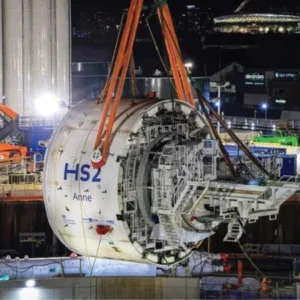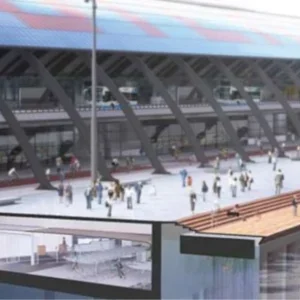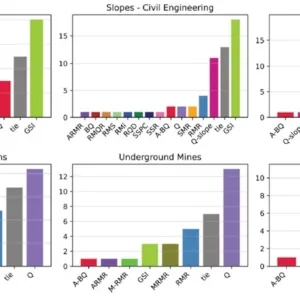The presentation started with a number of dramatic photographs of sinkholes in Singapore and Canada, demonstrating the damage to existing infrastructure that can occur, usually in public places. It was noted that sinkholes tended not to be picked up by monitoring points, as usually they occurred between these points. They were also usually associated with large ground movements at the tunnel face (rather than being due to collapses or other ground movements after tunnelling had been completed).
To distinguish between normal settlements and sinkholes, it was proposed that sinkholes be defined as settlements in excess of 150mm – such movements can be seen (i.e. detected without instrumentation), and represent a volume loss larger than about 10% for a typical 6m diameter subway running tunnel.
The experiences in Singapore, supplemented by data from Canada, showed that, whilst risk assessments of EPB tunnels almost invariably record a “negligible” risk of collapse, this is not borne out by experience. Table 1 shows that 56 incidents of large settlements occurred in 77km of tunnels, an average of one incident every 1.4km.
A number of published cases from other countries also suggest that the risks are not “negligible” – particularly where faces are in mixed ground, or where geological interfaces are close to the tunnel route, or when the TBM has just been launched.
North East Line, Singapore
Prior to discussing the precise causes of sinkholes, the new North East Line (NEL) in Singapore was outlined, including a detailed description of the geology of the island (Figure 1). The line ran principally through the Jurong Formation and Old Alluvium, with one section through Bukit Timah Granite. In several places paleochannels infilled with recent deposits (Kallang Formation) were encountered in the face or near the crown of the tunnel. The ground conditions in the Jurong Formation were described as consisting of mudstone, siltstones, limestones, sandstones and shales, generally deeply weathered. The weathered rock is highly variable in physical properties. In open face shields ravelling had been observed at faults and in beds of highly weathered mudstone.
A photograph was shown of an overbreak of 1m over an open face shield in a small fault zone. Photographs to illustrate the behaviour of the soils of the Kallang Formation showed soft clays squeezing into excavations (see p30), and saturated sand flowing through a small gap in a sheetpiled wall.
It was clear that normal numbers of boreholes would be unlikely to reveal the full detail of the variation in the weathered rocks, even with one borehole per 25m as adopted for the NEL. This level of investigation had, however, identified all of the infilled paleochannels that were encountered. As a matter of interest the LTA had commissioned approximately one borehole per 40m of route alignment, supplemented by the contractor’s own investigations later.
On the North East Line, tunnelling was undertaken using 14 x 6.46m to 6.60m diameter EPB machines with simultaneous tail shield grouting. The grout pipes were mainly laid inside the tailskin, with a few shields having the pipes externally mounted.
The experience overall was that the settlement control was good, 93% of the route being tunnelled with less than 2% ground loss. However, in 30 of 485 cases, actual settlements exceeded the maximum predicted value. In addition to the monitored settlement data, there had been 16 sinkholes/large local settlements over the tunnels (Figure 2).
Causes and risk factors for sinkholes
The incidents were examined separately for each set of geological conditions, and confirmed the general conclusions that sinkholes occurred: i) at or near to launching chambers or reception shafts; ii) where mixed faces or geological boundaries were in or near the tunnel face; and iii) where the face pressure was significantly below the natural water pressure.
The most problems were encountered in the weathered rocks and were attributed to inadequate face pressure and over-excavation, the latter being detected by counting muck-skips. In the Kallang Formation, experience showed that a face pressure in the range 0.9 to 1.2 times overburden pressure was needed to keep volume loss below 2%, assuming effective tail void grouting. This also applied if the Kallang was within 3m of the TBM. The residual soils and the Fort Canning Boulder Bed could generally be tunnelled without face pressure, but some face pressure was helpful in keeping settlements small. The Bukit Timah Granite, the Jurong Formation and the Old Alluvium contained beds or weathering grades which behaved in a granular manner, and a face pressure to balance the initial groundwater pressure was necessary to control the face where these beds/grades were encountered. In these formations the face conditions could change very rapidly. An example was given of an open face shield working in the Jurong Formation, where the face conditions changed from requiring blasting to requiring full face timbering in one ring of advance.
The question was then “why not apply full earth pressure all the time, to obviate the risk of settlement?” Wear and tear of cutters, picks and the TBM itself was the obvious answer, the point being graphically illustrated by a picture of a screw conveyor, reduced to less than half of it’s original size by abrasion.
The 56 cases of high settlement were broken down into the following risk factors:
A series of slides illustrated the sealing problems associated with launching an EPB machine into water-bearing ground, and the consequent ground instability that can occur.
Recommendations for minimising the risks
The speaker concluded with a list of measures recommended to minimise the risk of large settlements in conditions similar to those in Singapore:
Recommendations for matters that ought, as a matter of specification, to be covered by construction Method Statements were also put forward:
Trials were currently in progress to assess the use of belt weighing and belt scanning as means to measure the volume of muck excavated and provide rapid detection of over-excavation.
Related Files
Fig 2 – Histogram of settlement measurements from the 485 settlement points over EPB tunnels in Singapore
Fig 1 – Geology along the route of the North East Line, Singapore






